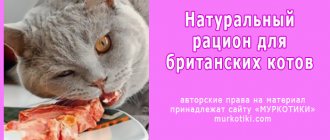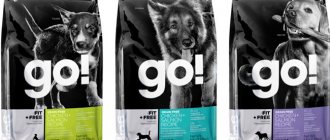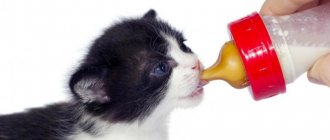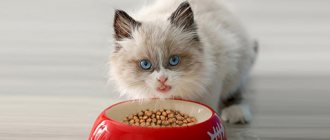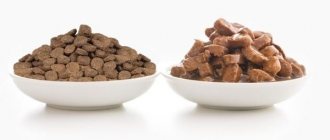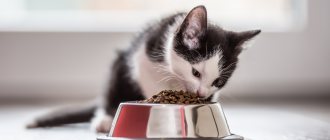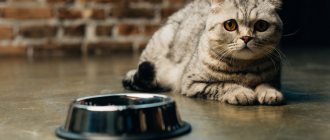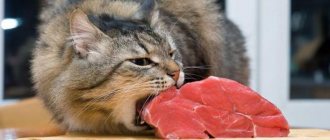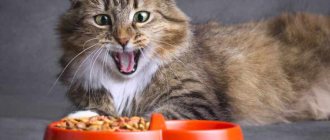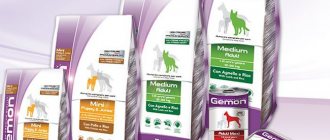Cats are carnivorous animals that prefer to eat several times a day, rather than just once, as in the wild. In addition, they do not eat more than they need. However, the amount of daily cat food depends on several factors, such as the animal's age, size, physical activity, or personality. We must provide them with a balanced and high-quality diet so that they do not gain excess weight or, conversely, suffer from malnutrition.
We will show you how to properly feed these pets depending on what stage of their life they are at and what the norm of cat food is. Remember that the daily amount of food for an adult cat will be different from the daily amount of food for a kitten or older cat.
Feeding nursing kittens
Lactating kittens are fully weaned after about 8 weeks, so it is recommended that they not be fed anything other than breast milk until then. They do not need any additional foods that provide them with more nutrients. Breast milk contains absolutely everything these little animals need, so don't worry about kittens consuming the right amount of milk. If we see baby cats wailing or fussing, they may not be full and need more milk.
© shutterstock
If you are unable to give them breast milk, ready-made milk replacers are available from veterinarians and specialty stores, but it is always recommended to feed them naturally from their birth mothers.
From the fourth week we can introduce solid food/special kitten food, crushed and soaked in water to a puree consistency. Then they can begin to get used to this food. The first weeks of a cat's life are critical for healthy development and growth.
Antibody test
Antibodies to coronavirus detected in the body show its reaction to the pathogen. If it produces specific immunoglobulins, this may mean that:
- the person has had COVID-19 (including asymptomatic);
- antibodies are able to fight the virus if it re-enters the blood;
- a person can be a donor and save other infected people who suffer more severely from the disease.
If testing shows that antibodies to coronavirus are present, this does not mean that their carrier will never get sick again.
Although the statistics are small, virologists have concluded that a positive antibody test may briefly equate to vaccination. However, this is true for six months after the infection is detected. After this period, risks reappear, and the patient is recommended to be vaccinated.
Food norm for a kitten
- From 8 weeks (after weaning) to 4 months, young cats should be given 5 servings of food per day, of which 5 grams of dry or wet food per serving.
Remember that these animals usually do not drink much water, so you should alternate dry food with wet food to replenish the lack of fluids. So, if you need to feed them 5 times a day in the first months of life, as already mentioned, try for example giving 2 servings of dry food and 3 servings of wet food.
At this stage of their life, their stomach is very small and cannot hold large amounts of food for each meal, but as our pet grows, they will require a little more food at each sitting.
- So, from 4 to 6 months, it is necessary to increase their portions by 10 grams per meal so that they do not lack nutrients. You should always try to maintain their ideal weight.
- After 6-8 months, you should reduce their food intake to 3 meals a day, with 20-30 grams per serving.
- And from 8 to 12 months you should reduce meals to 2 times a day.
This pattern will continue throughout their adult life, which begins at the age of one year. Please remember that the data we provide here is from a general perspective and the exact measurements of food and calories they will eat per day will depend on your pet's health and weight. If you have any questions, consult your trusted veterinarian immediately.
How to feed a cat correctly
Your cat's nutrition should be given special attention from the moment it arrives in your home. If possible, a small cat should be fed foods familiar to it so that it quickly adapts to new, unusual conditions. As your pet grows, you should increase the amount and calorie content of food . Also, the diet should be revised after the cessation of active growth to prevent the development of obesity. Feeding a pregnant or lactating cat requires close attention, as it directly affects the health of the future offspring.
When compiling a daily diet for a cat, keep in mind that protein should contain 60-65% of the total food.
Fats, carbohydrates and minerals account for the remainder. Dry food contains everything you need, so using it will make it much easier for you to organize proper nutrition for your pet.
© shutterstock
How much food should an adult cat eat?
From the age of 12 months, our cat will already be an adult and, as mentioned above, the amount of daily food will depend on weight, physical activity and the personality of the breed. But as a rule of thumb, a healthy cat needs about 15 to 20 grams of dry food per kilogram of body weight during normal daily activity. The recommended amount of wet cat food is 1/2 or 1 can per day. Ideally, you should first check the package instructions for the exact quantities based on food type and weight. However, if this information is confusing, you can follow these guidelines:
- If your cat weighs 1 kg, you should give her about 15-20 grams of dry food per day.
- ... 2 kg, from 30 to 40 grams.
- ... 3 kg, from 45 to 60 grams.
- ... 4 kg, from 60 to 80 grams.
- ... 5 kg, from 75 to 100 grams.
- ... 6 kg, from 90 to 120 grams.
- ... 7 kg, from 105 to 140 grams.
Keep in mind that these measurements are for cats with moderate physical activity and no known health problems or allergies. For example, if you have a pregnant cat, she needs more protein, fat, and calcium to properly develop the pregnancy.
© shutterstock
Another way to know what your cat's daily food intake is is to know how many calories she should be consuming based on her body weight. So, here is some rough information that relates to the energy needs of a typical healthy adult cat:
- If a cat weighs 1 kg, she should eat 100 kilocalories per day.
- ... 2 kg, they must ingest 160 kilocalories.
- ... 3 kg, they should take 210 kilocalories.
- ... 4 kg, they must eat 250 kilocalories.
- ... 5 kg, they should eat 290 kilocalories.
- ... 6 kg, they should consume 330 kilocalories.
- ... 7 kg, they must eat 370 kilocalories.
As mentioned earlier, an adult cat's food intake should be divided into 2 servings per day, so it is recommended to alternate dry and wet food in order to feed our pet correctly and safely.
Features of feeding a cat at different stages of life
Preparation for mating
At this stage, a balanced daily diet is necessary. Excess weight can lead to a decrease in the number of kittens in the litter and problems with fertilization. Insufficient weight provokes exhaustion during feeding and insufficient lactation.
First trimester of pregnancy
Cats' needs increase linearly, from the first day until the end of pregnancy. It is recommended to use specialized food for pregnant and lactating cats.
Second and third trimesters
In the second week after mating, there may be a slight decrease in appetite. Maximum nutritional needs increase at 6-7 weeks (by 25-50%). In the last week before birth, needs decrease.
Childbirth
A complete refusal to feed a day before birth is the norm. It is important to provide sufficient water. On the first day after birth, it is recommended to offer cats diluted wet food.
Lactation - key points:
- Sufficient amount of water is required. Energy and nutrient requirements increase immediately.
- A sufficient amount of protein (at least 35% in dry matter, mainly of animal origin), fats (Omega-3) and calcium, energy requirements increase threefold.
- During lactation, the animal should not lose more than 5-10% of its normal weight.
Feeding kittens
As a rule, starting from the fourth week, the cat begins to avoid the kittens itself. Complementary feeding for kittens begins in the third or fourth week. From the sixth to eighth week, kittens are weaned. We start with ¾ of the daily norm, the last milk feeding in the morning, in three to four days we will transfer the daily norm to the full one. It is recommended that kittens be allowed to try and get acquainted with different types of food (dry, pate, pouch, natural products). This will subsequently help avoid noophobia (fear of new foods).
Features of nutrition after castration
Changes in metabolism after castration often lead to weight gain, especially with uncontrolled feeding. To prevent excess weight, it is recommended to increase your pet’s physical activity and reduce the caloric content of the diet.
Features of nutrition for seniors
Senior cats - from ten to twelve years old. The protein requirements of a senior cat are higher than those of young animals. Ready-made senior/light food is not suitable for all senior cats, as they do not always take into account concomitant diseases and pathologies that the pet develops in old age.
Food allowance for an old cat
From 7/8 years old our animal will change from an adult cat to a senior cat and as a result their ability to digest proteins and fats will decrease. Therefore, it is necessary to continue to feed them 2 servings per day, but with high-quality and easily digestible food.
In addition to their ability to digest, we will notice other changes in our pet, such as the quality of the coat (less shiny). Or the amount of daily physical activity that makes them less active and energetic. However, this process is inevitable, but we can significantly extend the life of our companion if we feed him in a way that is appropriate for his age.
Essential Nutrients
PROTEINS (protein) are important components of the diet that supply the body with amino acids involved in the process of growth and repair of body tissues. Amino acids, in turn, as a result of metabolic processes, can release energy, and in the same amount per unit of weight as carbohydrates (4 kcal/kg).
The main assessment of the biological value (quality) of a protein is its digestibility and amino acid composition:
- Protein with a digestibility of 85% or higher is considered highly digestible;
- the most highly digestible egg and milk protein (up to 99%);
- muscle meat is a highly digestible protein;
- tripe, offal, trimmings - have average digestibility;
- vegetable proteins (without additional processing) for cats have average digestibility and an unbalanced amino acid composition.
The lower the degree of protein digestibility, the more of it should be in the feed to meet the animal’s needs.
Protein sources:
- animal origin (meat, fish, eggs, milk) - balanced amino acid composition (with a variety of sources), better digestibility;
- plant origin (cereals, vegetables, legumes) - unbalanced amino acid composition, less digestibility.
Protein deficiency:
- slower growth and development;
- decreased immune function;
- anemia;
- skin and intestinal infections;
- loss of muscle mass;
- deterioration of coat condition;
- reproductive dysfunction.
Excess protein:
- toxicity due to excess protein was found only when feeding synthetic amino acids;
- impaired growth of intestinal microflora (overgrowth of clostridia), which in some cases can cause diarrhea;
- excess of difficult-to-digest proteins (rich in connective tissue).
Excess protein is contraindicated in most liver and kidney pathologies.
FATS (lipids) are substances that also provide the body with energy, but in a more concentrated form (twice as much as carbohydrates and proteins - 8 kcal/g). Promote the absorption of fat-soluble vitamins (A, D, E, K) and serve as a source of essential fatty acids (linoleic, alpha-linolenic, arachidonic). In turn, essential fatty acids are necessary for certain body functions and are just as important as vitamins and minerals.
Sources: animal (solid and liquid), such as fish oil, and vegetable (soft and liquid), such as coconut oil.
Fat deficiency:
- deterioration of skin and coat condition;
- pathologies during the reproductive period.
Excess fat leads to a risk of obesity due to the high energy density of the diet.
Dry food granules are treated with a mixture of fats and tocopherols (vitamin E). In the open air they oxidize (go rancid), so the use of feed sold “by weight” is unacceptable.
CARBOHYDRATES are substances that supply the body with energy (4 kcal/g). Can be converted to fat. They include both simple sugars (glucose) and complex molecules (starch, cellulose, etc.). Cats have no direct needs. Cats metabolize carbohydrates up to 25% of dry matter.
Carbohydrates are not associated with diabetes risk. The connection may be indirect - for example, through excess weight.
FIBER : soluble/insoluble, fermentable/non-fermentable. Fiber is necessary for the normal functioning of the digestive tract. Insoluble fiber enhances peristalsis, while soluble fiber envelops the bolus of food, protecting the intestinal walls. Fermentable fiber serves as a substrate for microflora.
Vegetables are the main source of fiber for cats. Exception: bananas and boiled potatoes are sources of carbohydrates.
MINERALS:
- calcium and phosphorus – deficiency/excess affect the condition of the musculoskeletal system. Not only the absolute content is important, but also the ratio (optimally 1.2-1.5:1);
- zinc and copper affect the condition of the musculoskeletal system in juniors;
- calcium, phosphorus and magnesium are components of uroliths;
- Zinc deficiency is clinically manifested as a deterioration in the condition of the coat, and parakeratosis occurs less frequently.
VITAMINS:
- deficiency of fat-soluble vitamins leads to poor skin and coat condition and decreased immunity;
- excess vitamin D is toxic;
- excess vitamin A is toxic to cats - ossification (ossification) of cartilage tissue, spondylosis, synarthrosis of peripheral joints occurs;
- B vitamins are destroyed when exposed to high temperatures (if storage conditions are violated);
- Excess Omega-3 with vitamin E deficiency can lead to panniculitis (inflammation of fatty tissue) in cats.
How much does a cat need to eat? — General Considerations
If you're still wondering how much a cat should eat, here's what you need to consider:
- It is recommended to always leave cat food at their disposal because they can ration it themselves and only eat it when they are hungry and not for pure pleasure. If you don't do this, your cat will likely become anxious while waiting for food to arrive and may become stressed (with associated consequences).
- Cats are creatures of habit, so it is advisable for them to have a set daily routine as soon as they become adults.
- Following the routine task is to feed them every day in the same place and at the same time, in a quiet place and always away from their litter box.
- To feed your cat, use a mat or easy-to-clean surface on which you place a metal or ceramic bowl. Some cats prefer to eat in a flat feeder, and this helps them avoid eating too quickly.
- If you have more than one cat, you should make sure that each of them has an appropriate feeder at a considerable distance to prevent them from fighting or eating each other's food.
- Remember to keep an eye out for banned cat foods to avoid health problems.
Article by: Josie F. Turner Journalist specializing in animal welfare.
What to feed your cat
The following products can be included in the diet:
| Meat | It is better to choose lean beef or chicken. It is acceptable to use rabbit or lamb. Pork is strictly prohibited! The meat is given raw, but is first doused with boiling water. However, some cats prefer the boiled product. |
| Fish | Choose lean sea fish, clean it from bones, and boil it. However, you should not abuse “fish days”. Fish can be given once a week instead of meat. Fish should not be given to spayed or neutered male or female cats! |
| By-products | You can give your cat heart, lungs, liver or kidneys. However, keep in mind that their calorie content and healthiness are lower than that of meat. Offal is given raw, no more than 2 times a week. But these foods cause diarrhea and vomiting in many cats, so be careful. |
| Fermented milk products (kefir, cottage cheese, cheese, sour cream) | They should make up 50% of the cat's diet. Fat content should not exceed 9%. But low-fat ones are also not very healthy: they can lead to diarrhea. The cat's body does not digest milk well. |
| Vegetables | A cat can eat almost any vegetables: pumpkin, beets, carrots, cabbage, peppers. Focus on your pet's preferences. Vegetables are finely chopped, served raw or stewed in water, you can add oil. It is not recommended to give potatoes. |
| Eggs | Quail or chicken can be added to cottage cheese or kefir (1 piece per week). |
| Bran | Can replace vegetables, they are good for digestion. They are often mixed with meat or dairy products. |
| Oil | Flaxseed, pumpkin, vegetable, olive are added to food (no more than 5 drops), and have a beneficial effect on digestion. |
| Cereals | Hercules, rice can be given in small quantities in the form of porridge (meat broth or water). They are mixed with meat or fish. |
Is your cat eating properly?
If your cat is energetic, playful, moderately well-fed, and her coat is shiny and silky, then you are feeding her correctly.
Remember that as you age, your diet adjusts. Kittens need more minerals and protein.
After 7 years, the portion is reduced, the amount of protein is reduced slightly, as the cat becomes less active. As for an older cat, try to give smaller pieces and warm the food slightly (up to 35 degrees).
To be on the safe side, give your cat a blood test for biochemistry once every 1.5 years. This will determine if your cat is getting enough nutrients.
Normal for a neutered cat
Owners are interested in whether it is necessary to rebuild the cat’s diet after castration. After all, with the loss of the sexual instinct in animals, their behavior also changes: they move much less, while they are even more interested in food than before.
It is not necessary to switch to special food, but it won’t hurt to monitor the feeding rate and weigh the cat periodically. If your pet weighs 5 kg or more, you should start with the dosage in the “Overweight” column and carry out a control weighing after a month. If the cat is losing weight at the suggested norm, the portions can be slightly increased, remaining within the indicator in the “Normal fatness” column.

